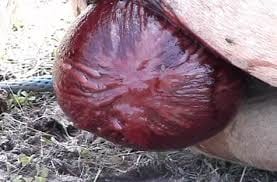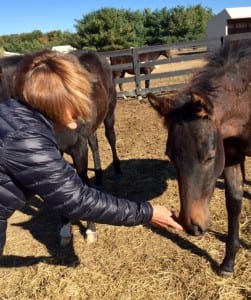Every year, hundreds of mares deliver healthy foals without incident. A new foal arriving is an exciting time and a miracle to watch, but it can also be a high-level energy environment needing split-second decision-making. Knowing when to call the veterinarian is an integral part of being prepared for foaling and enables the caretaker to remain calm and collected which, in turn, helps both the mare and the new foal.
GoHorseShow asked Debbie Trubee, owner of North Farm in North Lawrence, Ohio, and breeding manager Lauren Erk of Leeman Farm in Massillon, Ohio, for their advice about when it’s time to call the vet.
Dystocia During Foaling
 Foaling problems are very stressful for most practitioners, mares, and horse owners. Dystocia is a difficult birth in which the mare does not deliver the foal within the typical 30-minute period or in a standard presentation, position, and posture. Unfortunately, there is no way to predict if a mare may be at risk for dystocia. Additionally, some mares are very dramatic during the stages of labor, and it can be hard to tell the difference between having an issue or just one with a lower pain tolerance, noted Trubee.
Foaling problems are very stressful for most practitioners, mares, and horse owners. Dystocia is a difficult birth in which the mare does not deliver the foal within the typical 30-minute period or in a standard presentation, position, and posture. Unfortunately, there is no way to predict if a mare may be at risk for dystocia. Additionally, some mares are very dramatic during the stages of labor, and it can be hard to tell the difference between having an issue or just one with a lower pain tolerance, noted Trubee.
Erk explained, “We have cameras in our foaling stalls and are present at every birth to assist if necessary. We stay outside the stall in the early stages, so we do not interfere or stress the mare out. However, once the mare’s water has broken, we check to ensure that the front feet and head are in the correct position (diving position), and if not, act accordingly.”
 Active contractions and progress should occur within 15 minutes of the water breaking. Call a veterinarian immediately if the mare has heavy contractions with no signs of feet or an amniotic bubble within that time frame or appears in distress. Foaling itself should be a quick procedure; it is what should happen afterward with the foal and mare that takes a few hours.
Active contractions and progress should occur within 15 minutes of the water breaking. Call a veterinarian immediately if the mare has heavy contractions with no signs of feet or an amniotic bubble within that time frame or appears in distress. Foaling itself should be a quick procedure; it is what should happen afterward with the foal and mare that takes a few hours.
Trubee added, “If your mare doesn’t start delivery soon after the water breaks, there could be a problem. We reach in our mares to make sure we can feel two feet and a nose after the water breaks; if you don’t find those parts, this is the chance to correct the foal before they get too far into the birth canal. A leg back or nose back can be corrected at this time. Other, more severe malpositions can’t be.” Vet assistance will be required immediately if the malposition cannot be corrected.
 Debbi described, “When a mare has started into labor and wants to get up and down and roll, we let them. Sometimes the mare can reposition the foal to correct small problems.” But, if two feet and a nose aren’t seen or felt, this is the time to intervene. Trubee encourages mare owners to read articles and research ways to correct minor problems. While it sounds scary, if the mare owner familiarizes themselves with what to do, things can be made right quite often, with just a little help.
Debbi described, “When a mare has started into labor and wants to get up and down and roll, we let them. Sometimes the mare can reposition the foal to correct small problems.” But, if two feet and a nose aren’t seen or felt, this is the time to intervene. Trubee encourages mare owners to read articles and research ways to correct minor problems. While it sounds scary, if the mare owner familiarizes themselves with what to do, things can be made right quite often, with just a little help.
Other Complications
The list of other complications is long. While almost all mares foal with no difficulties, there are times when everything goes south. “Vulvar tears are not uncommon, and a foot can get misdirected and go through the rectum,” described Trubee. Call your vet immediately if the mare’s water has broken and a leg or head is coming rectally.
 Another serious complication is a red bag delivery. Red bag delivery is if water has not broken, and a red mass appears; the mare needs attention immediately. Red bag delivery is when the placenta has detached from the uterine lining, and the foal will suffocate as it no longer has an oxygen supply. The placenta is a thick tissue and cannot be pulled/torn into like the amniotic sac, it will need to be cut open with a blade or scissors, and the foal must be in the correct position to continue foaling.
Another serious complication is a red bag delivery. Red bag delivery is if water has not broken, and a red mass appears; the mare needs attention immediately. Red bag delivery is when the placenta has detached from the uterine lining, and the foal will suffocate as it no longer has an oxygen supply. The placenta is a thick tissue and cannot be pulled/torn into like the amniotic sac, it will need to be cut open with a blade or scissors, and the foal must be in the correct position to continue foaling.
“If the mare is foaling and everything is proceeding as it should, but the foal is large, we will assist with pulling a foal if need be and have chains to help apply tension only when the mare pushes,” explained Erk. Once the shoulders have passed, the foal must get out as the umbilical cord becomes crimped along the pelvic brim, and oxygen is cut off.
After Care
 Depending on the severity of the complication dictates what the treatment will be. The vet will repair mares that may have a small vulvar tear at a different time. For a mare that retains her placenta, the vet needs to be called to come and address this as soon as possible. “Generally, those mares will be put on systemic antibiotics and flushed or infused several days post-foaling. It’s always best to have your vet out the morning after delivery to give the mare a foal a complete checkup,” described Trubee.
Depending on the severity of the complication dictates what the treatment will be. The vet will repair mares that may have a small vulvar tear at a different time. For a mare that retains her placenta, the vet needs to be called to come and address this as soon as possible. “Generally, those mares will be put on systemic antibiotics and flushed or infused several days post-foaling. It’s always best to have your vet out the morning after delivery to give the mare a foal a complete checkup,” described Trubee.
After foaling, within three hours, the foal should stand, nurse, pass meconium, and the mare should pass her placenta. “Every foal varies on when it stands – we typically say fillies will stand and nurse quicker than colts – but they should all make attempts of trying to move around within the first 30 minutes. After that, some will be more aggressive about it, but they should all attempt to get sternal,” clarified Erk.
 “If the foal does not make attempts to stand, seems weak, doesn’t seem interested in nursing, or has no nurse reflex, call your vet immediately as you could have a dummy foal and will need medical assistance,” summarized Erk. Additionally, the amniotic sac must be cleared from the foal’s head so it doesn’t suffocate once out of the mare. Finally, Erk explained, “We usually try to make sure it is torn once the shoulders are through.”
“If the foal does not make attempts to stand, seems weak, doesn’t seem interested in nursing, or has no nurse reflex, call your vet immediately as you could have a dummy foal and will need medical assistance,” summarized Erk. Additionally, the amniotic sac must be cleared from the foal’s head so it doesn’t suffocate once out of the mare. Finally, Erk explained, “We usually try to make sure it is torn once the shoulders are through.”
Erk continued, “After foaling, we will leave the foal attached to the placenta and behind the mare as long as the mare is quiet and lying there. There is still blood being supplied through the placenta. However, if the mare starts to roll around or jumps up, we will pop the umbilical and pull the foal out of the way so it does not get stepped or rolled on. We will also detach the cord if there is a lot of tension on the naval to help avoid an umbilical hernia from forming.” Erk also suggests spraying the foal’s naval with Nolvasan and giving an enema to help pass the meconium.
 As the foal becomes active, Erk says they will detach the placenta and move the foal in front of the mare to bond. “We leave mare and foal alone during this time, but will continue to observe via cameras. We will have a lead rope on the mare for maiden mares during the initial meeting stages, especially once the foal starts moving around and trying to stand. We want to make sure that one, they show interest in what the foal is, and two, don’t try to reject/attack the foal due to being unknown and associating the foal with the labor contractions,” reviewed Erk.
As the foal becomes active, Erk says they will detach the placenta and move the foal in front of the mare to bond. “We leave mare and foal alone during this time, but will continue to observe via cameras. We will have a lead rope on the mare for maiden mares during the initial meeting stages, especially once the foal starts moving around and trying to stand. We want to make sure that one, they show interest in what the foal is, and two, don’t try to reject/attack the foal due to being unknown and associating the foal with the labor contractions,” reviewed Erk.
Within three hours, the mare should pass the placenta. If not, the mare will need to be started on vet-prescribed medication protocol and antibiotics, pending the situation. A retained placenta is not an emergency call to the vet in the middle of the night, but Erk recommends calling the vet soon to help to extract the placenta and lavage the mare.
 Additionally, Erk explains, “There will be blood from the placenta detaching and some ripping, especially if the foal is larger or the mare was not as relaxed in the vulva area. However, if you think there is a lot of blood present or notice active blood coming from the mare, call your vet, as there could be some damage requiring attention.”
Additionally, Erk explains, “There will be blood from the placenta detaching and some ripping, especially if the foal is larger or the mare was not as relaxed in the vulva area. However, if you think there is a lot of blood present or notice active blood coming from the mare, call your vet, as there could be some damage requiring attention.”
Foaling at home can be highly stressful, and it’s essential to work under pressure and give IV medications if needed, or the mare should be foaled out at a vet’s clinic or breeding farm. “If you are foaling at home, make sure that you have cell service in your barn, your vet clinic number saved in your phone, and on speed dial, any  medications your vet has provided beforehand to manage until either they can arrive at your facility or for you to take the mare to the clinic, and a trailer hooked up at all times ready to go,” said Erk. Additionally, foal alerts are an excellent tool to help notify the mare is foaling, but it should not be the only way you rely on knowing the mare foaling.
medications your vet has provided beforehand to manage until either they can arrive at your facility or for you to take the mare to the clinic, and a trailer hooked up at all times ready to go,” said Erk. Additionally, foal alerts are an excellent tool to help notify the mare is foaling, but it should not be the only way you rely on knowing the mare foaling.
“While the loss of a mare does happen, even if a vet is in attendance, it is uncommon,” described Trubee. A mare owner is never wrong to call the vet. “Even if you end up just getting reassurances that everything is normal, if you feel something is wrong, call the vet at the first sign of what you feel may be trouble,” Trubee concluded.








